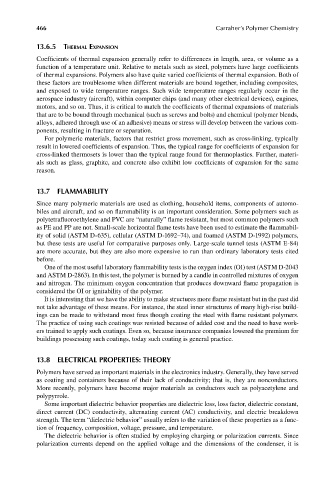Page 503 - Carrahers_Polymer_Chemistry,_Eighth_Edition
P. 503
466 Carraher’s Polymer Chemistry
13.6.5 THERMAL EXPANSION
Coefficients of thermal expansion generally refer to differences in length, area, or volume as a
function of a temperature unit. Relative to metals such as steel, polymers have large coeffi cients
of thermal expansions. Polymers also have quite varied coefficients of thermal expansion. Both of
these factors are troublesome when different materials are bound together, including composites,
and exposed to wide temperature ranges. Such wide temperature ranges regularly occur in the
aerospace industry (aircraft), within computer chips (and many other electrical devices), engines,
motors, and so on. Thus, it is critical to match the coeffi cients of thermal expansions of materials
that are to be bound through mechanical (such as screws and bolts) and chemical (polymer blends,
alloys, adhered through use of an adhesive) means or stress will develop between the various com-
ponents, resulting in fracture or separation.
For polymeric materials, factors that restrict gross movement, such as cross-linking, typically
result in lowered coefficients of expansion. Thus, the typical range for coefficients of expansion for
cross-linked thermosets is lower than the typical range found for thermoplastics. Further, materi-
als such as glass, graphite, and concrete also exhibit low coefficients of expansion for the same
reason.
13.7 FLAMMABILITY
Since many polymeric materials are used as clothing, household items, components of automo-
biles and aircraft, and so on flammability is an important consideration. Some polymers such as
polytetrafluoroethylene and PVC are “naturally” flame resistant, but most common polymers such
as PE and PP are not. Small-scale horizontal flame tests have been used to estimate the fl ammabil-
ity of solid (ASTM D-635), cellular (ASTM D-1692–74), and foamed (ASTM D-1992) polymers,
but these tests are useful for comparative purposes only. Large-scale tunnel tests (ASTM E-84)
are more accurate, but they are also more expensive to run than ordinary laboratory tests cited
before.
One of the most useful laboratory flammability tests is the oxygen index (OI) test (ASTM D-2043
and ASTM D-2863). In this test, the polymer is burned by a candle in controlled mixtures of oxygen
and nitrogen. The minimum oxygen concentration that produces downward flame propagation is
considered the OI or ignitability of the polymer.
It is interesting that we have the ability to make structures more flame resistant but in the past did
not take advantage of these means. For instance, the steel inner structures of many high-rise build-
ings can be made to withstand most fires though coating the steel with flame resistant polymers.
The practice of using such coatings was resisted because of added cost and the need to have work-
ers trained to apply such coatings. Even so, because insurance companies lowered the premium for
buildings possessing such coatings, today such coating is general practice.
13.8 ELECTRICAL PROPERTIES: THEORY
Polymers have served as important materials in the electronics industry. Generally, they have served
as coating and containers because of their lack of conductivity; that is, they are nonconductors.
More recently, polymers have become major materials as conductors such as polyacetylene and
polypyrrole.
Some important dielectric behavior properties are dielectric loss, loss factor, dielectric constant,
direct current (DC) conductivity, alternating current (AC) conductivity, and electric breakdown
strength. The term “dielectric behavior” usually refers to the variation of these properties as a func-
tion of frequency, composition, voltage, pressure, and temperature.
The dielectric behavior is often studied by employing charging or polarization currents. Since
polarization currents depend on the applied voltage and the dimensions of the condenser, it is
9/14/2010 3:42:17 PM
K10478.indb 466 9/14/2010 3:42:17 PM
K10478.indb 466

